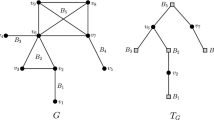Abstract
For a fixed integer \(b>1\), a set \(D\subseteq V\) is called a b-disjunctive dominating set of the graph \(G=(V,E)\) if for every vertex \(v\in V{\setminus }D\), v is either adjacent to a vertex of D or has at least b vertices in D at distance 2 from it. The Minimum b-Disjunctive Domination Problem (MbDDP) is to find a b-disjunctive dominating set of minimum cardinality. The cardinality of a minimum b-disjunctive dominating set of G is called the b-disjunctive domination number of G, and is denoted by \(\gamma _{b}^{d}(G)\). Given a positive integer k and a graph G, the b-Disjunctive Domination Decision Problem (bDDDP) is to decide whether G has a b-disjunctive dominating set of cardinality at most k. In this paper, we first show that for a proper interval graph G, \(\gamma _{b}^{d}(G)\) is equal to \(\gamma (G)\), the domination number of G for \(b \ge 3\) and observe that \(\gamma _{b}^{d}(G)\) need not be equal to \(\gamma (G)\) for \(b=2\). We then propose a polynomial time algorithm to compute a minimum cardinality b-disjunctive dominating set of a proper interval graph for \(b=2\). Next we tighten the NP-completeness of bDDDP by showing that it remains NP-complete even in chordal graphs. We also propose a \((\ln ({\varDelta }^{2}+(b-1){\varDelta }+b)+1)\)-approximation algorithm for MbDDP, where \({\varDelta }\) is the maximum degree of input graph \(G=(V,E)\) and prove that MbDDP cannot be approximated within \((1-\epsilon ) \ln (|V|)\) for any \(\epsilon >0\) unless NP \(\subseteq \) DTIME\((|V|^{O(\log \log |V|)})\). Finally, we show that MbDDP is APX-complete for bipartite graphs with maximum degree \(\max \{b,4\}\).



Similar content being viewed by others
References
Alimonti P, Kann V (2000) Some APX-completeness results for cubic graphs. Theor Comput Sci 237:123–134
Ambalath AM, Balasundaram R, Rao C, Koppula V, Misra N, Philip G, Ramanujan MS (2010) On the kernelization complexity of colorful motifs. In: IPEC, Lecture Notes in Computer Science, 6478:14–25
Ausiello G, Crescenzi P, Gambosi G, Kann V, Marchetti-Spaccamela A, Protasi M (1999) Complexity and approximation. Springer, Berlin
Bertossi AA (1984) Dominating sets for split and bipartite graphs. Inf Process Lett 19(1):37–40
Chang MS (1998) Efficient algorithms for the domination problems on interval and circular-arc graphs. SIAM J Comput 27(6):1671–1694
Chlebík M, Chlebíková J (2008) Approximation hardness of dominating set problems in bounded degree graphs. Inf Comput 206:1264–1275
Dankelmann P, Day D, Erwin D, Mukwembi S, Swart H (2009) Domination with exponential decay. Discrete Math 309:5877–5883
Fulkerson DR, Gross OA (1965) Incidence matrices and interval graphs. Pac J Math 15:835–855
Goddard W, Henning MA, McPillan CA (2014) The disjunctive domination number of a graph. Quaest Math 37(4):547–561
Haynes TW, Hedetniemi ST, Slater PJ (1998a) Fundamentals of domination in graphs. Marcel Dekker Inc., New York
Haynes TW, Hedetniemi ST, Slater PJ (1998b) Domination in graphs, advanced topics. Marcel Dekker Inc., New York
Henning MA, Marcon SA (2015a) Domination versus disjunctive domination in trees. Discrete Appl Math 184:171–177
Henning MA, Marcon SA (2015b) A constructive characterization of trees with equal total domination and disjunctive domination numbers. Quaest Math 39:531–543
Henning MA, Naicker V (2014) Disjunctive total domination in graphs. J Comb Optim 31:1090–1110
Henning MA, Naicker V (2015) Graphs with large disjunctive total domination number. Discrete Appl Math 17:255–282
Henning MA, Naicker V (2016) Bounds on the disjunctive total domination number of a tree. Discuss Math Graph Theory 36:153–171
Jacobson MS, Peters K (1989) Complexity questions for \(n\)-domination and related parameters. In: Eighteenth Manitoba conference on numerical mathematics and computing (Winnipeg, MB, 1988) Congr. Numer. 68, 722
Jamison RE, Laskar R (1984) Elimination orderings of chordal graphs. In: Combinatorics and applications (Calcutta, 1982), ISI, Calcutta, pp 192–200
Panda BS, Das SK (2003) A linear time recognition algorithm for proper interval graphs. Inf Process Lett 87(3):153–161
Panda BS, Pandey A, Paul S (2015) Algorithmic aspects of disjunctive domination in graphs. In: COCOON, Lecture Notes in Computer Science 9198:325–336
Pandey A, Panda BS (2016) \(b\)-Disjunctive total domination in graphs: algorithm and hardness results. In: CALDAM, Lecture Notes in Computer Science 9602:277–288
Rajgopalan S, Vazirani VV (1999) Primal-dual RNC approximation algorithms for set cover and covering integer programs. SIAM J Comput 28:526–541
Acknowledgements
The authors would like to thank the anonymous reviewers for their valuable comments to improve the presentation of the paper. A part of this work was done when S. Paul was a NBHM Postdoc Fellow (No. 2/40(49)/2014/R&D-II/1581) at Indian Statistical Institute, Kolkata.
Author information
Authors and Affiliations
Corresponding author
Additional information
The work was done when the corresponding author (Arti Pandey) was in IIIT Guwahati.
Rights and permissions
About this article
Cite this article
Panda, B.S., Pandey, A. & Paul, S. Algorithmic aspects of b-disjunctive domination in graphs. J Comb Optim 36, 572–590 (2018). https://doi.org/10.1007/s10878-017-0112-6
Published:
Issue Date:
DOI: https://doi.org/10.1007/s10878-017-0112-6




